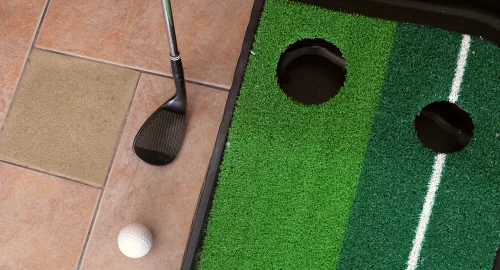
Fall golf is one of the best times of year to be on the course—crisp air, colorful trees, and usually less crowded fairways.
But cooler weather also means it’s time to make some subtle changes to your game. The combination of lower temperatures, damp turf, tighter lies, and wearing extra layers can throw off your swing if you’re not prepared.
The good news? You don’t need to overhaul your mechanics.
With a few simple adjustments—like managing your tempo, improving your balance, and knowing how to handle seasonal turf conditions—you can keep your game sharp and enjoy playing your best golf deep into the fall.
In this article, we’ll share practical, easy-to-implement tips to help you adapt your swing, maintain power, and stay consistent even when your body isn’t quite as loose as in summer.
How Cooler Weather Impacts Your Swing
Fall conditions affect your golf swing in more ways than you might realize.
First, the colder temperatures make your muscles and joints feel tighter, which limits your flexibility and makes it harder to turn fully. That can lead to rushed swings, mishits, and even some lost distance if you’re not careful.
You’ll also encounter softer, damp turf from morning dew, rain, or dormant grass—which means less roll-out and a higher chance of fat shots if you don’t adjust your setup and swing. Tight, thin lies are common in the fall as well, making it more difficult to make crisp contact.
Lastly, layering up to stay warm can restrict your motion and throw off your rhythm. Wearing bulky jackets or multiple layers changes how your body moves through the swing—and if you’re not ready for it, your balance and timing can suffer.
Layering Without Losing Your Swing
Staying warm is important in the fall, but wearing too many bulky layers can ruin your swing. The solution is smart layering that you can remove if the temperatures change during the round. Start with a fitted, moisture-wicking base layer to keep you warm and dry without restricting motion.
Add a thin, stretchy mid-layer and, if necessary, a lightweight windbreaker. Avoid anything heavy or overly baggy that could get in the way of your turn.
If possible, practice while wearing the same layers you plan to wear on the course. This helps you adjust to how the extra clothing feels during your swing, so it’s not a surprise on the first hole.
By planning your clothing and warm-up routine, you can stay comfortable and keep your swing fluid all round long.

Getting a Good Warm Up
Before providing any swing tips, make sure you warm up when the weather is colder. A good warm-up is essential in colder temperatures to avoid injuries and get the most out of your golf swing.
Your body isn’t as loose as it is on hot summer days, so take extra time to stretch, make some practice swings, and get your blood flowing before you hit your first tee shot. Engage in some light exercises at home, take plenty of practice swings, and hit the driving range to get your body loosened up.
Swing Tips for Damp Turf and Tough Lies
Next, you need to learn how to read lies and adapt accordingly. This is one of the most important parts of a good pre-shot routine; being able to assess the lie and figure out which shot will work the best.
Once you assess the lie, it’s essential to learn how to deal with softer turf and thinner lies. Damp, spongy fairways make it easier to hit behind the ball, while tight lies demand precision contact.
The key on damp turf is to prioritize clean, ball-first contact. Try moving the ball slightly back in your stance—just an inch or so—to encourage a steeper angle of attack.
Take one more club than usual (especially with mid-to-long irons) and focus on swinging smoothly, rather than trying to muscle the ball. This helps avoid chunked shots that barely make it to the green.
On tighter lies, balance becomes even more critical. Narrow your stance slightly for better control, and focus on keeping your lower body quiet through impact.
Your hands should stay quiet as well—no flipping the club to help the ball up. Let the loft of the club do the work and make a controlled, descending strike.
By making these small setup and swing tweaks, you’ll find yourself hitting crisper shots and scoring better even in tricky fall conditions.
Tempo & Balance: The Keys to Consistency in the Cold
When it’s cooler outside, it’s easy to tense up and rush your swing—especially with tighter muscles and less flexibility. But the colder it gets, the more important it is to stay smooth and balanced.
Start by consciously slowing down your tempo. A simple drill is to count in your head during your backswing to avoid jerky, rushed motions. Some players even pause slightly at the top of the swing to ensure balance and rhythm before transitioning into the downswing.
Stability is also important. Make sure you wear shoes with fresh spikes, get into a proper setup position and avoid overswinging. The goal is to feel in control of your swing and keep your body connected, even when it’s cold and your natural instinct is to swing harder.
How to Maintain Power When Your Body Isn’t Loose
Cooler weather often means a little less distance, but there are ways to keep your power without over-swinging. First, club up when needed—don’t be afraid to hit more club and swing within yourself rather than forcing extra speed.
Focus on maximizing rotation instead of just arm speed. A good turn, even if it feels shorter than normal, will help you generate consistent power. You can also tee the ball slightly higher on your drives to promote a higher launch and a little more carry distance.
Remember, a smooth, centered strike is more effective than a wild, fast swing in the cold. Prioritize clean contact, good tempo, and smart club selection to maintain your distance and score well.
Fall Golf is Just Around the Corner
Fall golf is one of the best times to play—cooler air, beautiful scenery, and often quieter courses. But to play your best, you need to adjust your game to match the conditions.
By making small tweaks—like playing the ball slightly back on damp turf, layering smartly, slowing down your tempo, and staying balanced—you can stay consistent even when the weather isn’t perfect. And remember: clean contact, not extra speed, is what will keep your scores low in cooler weather.
Use these tips to keep your swing sharp, embrace the challenge of fall golf, and enjoy every round well into the offseason.

